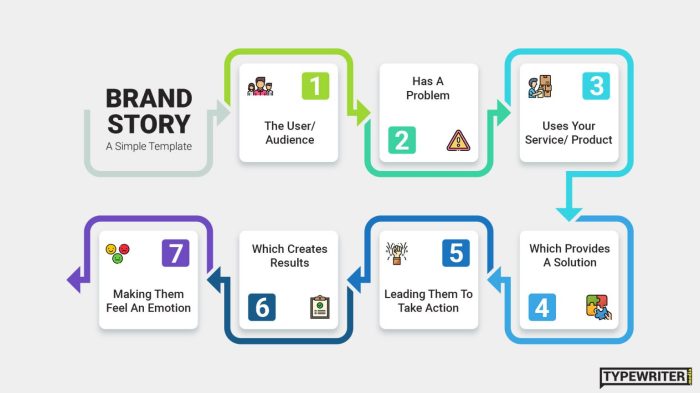Developing a Brand Story takes center stage, inviting readers into a world of brand storytelling filled with creativity and strategy. From defining brand identity to communicating through engaging content, this topic explores the art of crafting a compelling narrative that resonates with audiences.
Introduction to Brand Story
A brand story is the narrative that defines a company’s identity, values, and mission. It goes beyond just products or services, creating an emotional connection with customers.
Having a strong brand story is crucial for a company as it helps establish a unique identity, build trust with consumers, and differentiate from competitors in a crowded market.
Role of Brand Story in Brand Identity
- Defines company values and mission
- Creates emotional connection with customers
- Establishes a unique identity in the market
Components of a Brand Story
A brand story is made up of several key elements that help define the brand’s identity and connect with its audience on a deeper level. These components include brand values, mission, and vision.
Brand Values
Brand values are the guiding principles that shape a brand’s behavior and decision-making. They reflect what the brand stands for and how it wants to be perceived by its customers. By incorporating brand values into the brand story, a company can communicate its beliefs and create an emotional connection with its audience.
Mission
The mission of a brand defines its purpose and reason for existence. It articulates what the brand aims to achieve and how it plans to make a positive impact on the world. By incorporating the brand’s mission into the brand story, a company can inspire its audience and rally support behind a common goal.
Vision
A brand’s vision is a future-oriented statement that describes what the brand aspires to become. It sets a long-term direction for the brand and inspires employees and customers to work towards a shared vision. By incorporating the brand’s vision into the brand story, a company can paint a picture of a brighter future and motivate others to join them on the journey.
Storytelling Techniques for Brand Communication
Storytelling techniques can be used to effectively communicate these components of a brand story by creating a narrative that resonates with the audience. By using storytelling elements such as characters, plot, conflict, and resolution, a brand can bring its values, mission, and vision to life in a compelling and memorable way.
Examples of Successful Brand Stories: Developing A Brand Story
One example of a successful brand story is Nike, which communicates its brand values of determination, innovation, and athleticism through its “Just Do It” slogan. This simple yet powerful message has resonated with consumers worldwide and helped establish Nike as a leading sports brand.
Another example is Apple, which has built a brand story around its mission to challenge the status quo and create products that are beautifully designed and easy to use. By telling the story of its visionary founder, Steve Jobs, Apple has cultivated a loyal following of customers who are passionate about the brand.
Crafting a Brand Story

Developing a brand story that truly resonates with the target audience requires a deep understanding of the brand’s values, mission, and unique selling points. Here are some strategies to help you craft a compelling brand story:
Importance of Authenticity and Consistency
- Authenticity is key when telling your brand story. Consumers are drawn to genuine stories that reflect the true essence of your brand.
- Consistency in storytelling helps build trust and credibility with your audience. Make sure your brand story aligns with your brand’s values and is reflected in all marketing communications.
- Ensure that your brand story remains consistent across all platforms and channels to create a unified brand experience for your audience.
Aligning Brand Story with Marketing Strategy
- Integrate your brand story seamlessly into your overall marketing strategy to create a cohesive brand message.
- Identify the key messages and themes in your brand story that align with your marketing goals and objectives.
- Use your brand story to differentiate your brand from competitors and create a unique position in the market.
Communicating the Brand Story
Communicating the brand story is crucial for connecting with your audience and building brand loyalty. By utilizing different channels and platforms, you can effectively share your brand story and engage with customers in a meaningful way.
Utilizing Various Channels
- Website: Your website is the hub of your brand story. Make sure to have a dedicated section that showcases your brand’s history, values, and mission.
- Social Media: Platforms like Instagram, Facebook, and Twitter provide a great opportunity to share snippets of your brand story through posts, stories, and videos.
- Advertising: Utilize paid advertising on platforms like Google Ads or social media to reach a wider audience and communicate your brand story effectively.
Creating Engaging Content
- Know Your Audience: Tailor your content to resonate with your target demographic to create a deeper connection.
- Storytelling Techniques: Use storytelling elements like conflict, resolution, and relatable characters to make your brand story compelling.
- Visuals: Incorporate high-quality images, videos, and infographics to enhance your brand story and capture attention.
Visual Elements in Storytelling, Developing a Brand Story
Visual elements play a significant role in conveying your brand story effectively. The design, imagery, and branding elements you use can help create a cohesive narrative that resonates with your audience.
Evolving the Brand Story

As brands exist in a dynamic environment, it is crucial for a brand story to evolve over time to stay relevant, engage consumers, and remain competitive in the market.
Importance of Evolution
Adapting a brand story allows a company to reflect changes in consumer preferences, market trends, and feedback, ensuring that the brand remains authentic and resonates with its target audience.
- Feedback from customers provides valuable insights into their perceptions, allowing brands to make necessary adjustments to their story to better connect with their audience.
- Monitoring market trends helps brands stay ahead of the competition by incorporating relevant themes, language, and values into their evolving brand narrative.
- Consumer insights gathered through data analysis can inform the evolution of a brand story, enabling companies to create more personalized and engaging experiences for their customers.
Successful Adaptation Examples
- Apple: Apple has successfully evolved its brand story over the years, transitioning from a challenger brand to a global tech powerhouse by consistently innovating and focusing on user experience.
- Nike: Nike has adapted its brand story to reflect changing cultural attitudes towards sports, diversity, and social issues, staying relevant and resonating with a younger audience.
- Starbucks: Starbucks has adapted its brand story to emphasize sustainability, community engagement, and social responsibility, aligning with evolving consumer values and preferences.